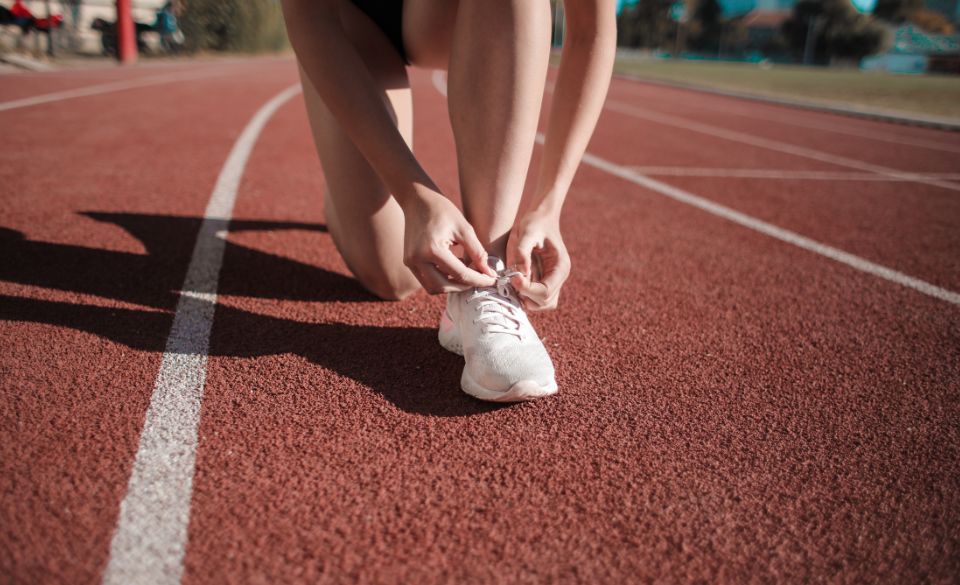
How To Beat Post Run Soreness
Page Contents
Have you ever found yourself limping through the day after a strenuous run, pondering why your muscles resemble those of a seasoned boxer post-match? Rest assured, you’re not alone!
Muscle soreness is like an unwelcome guest that crashes the party, serving as a reminder of the enjoyment (or, in this case, the run) you experienced. But what’s the reason behind it? Are your muscles merely drama queens, or is there more to the story? Spoiler alert: It’s not just drama.
Whether you’re a seasoned runner or a newbie lacing up your sneakers, muscle soreness doesn’t discriminate. However, beginners or those returning from a running hiatus tend to grapple with it more frequently. But fear not, there’s a way out, and we’re here to guide you through it.
This article delves into the two main types of exercise-induced soreness: immediate soreness during or after a run and the more familiar Delayed Onset Muscle Soreness (DOMS).
From the “Start Slow” principle, the significance of the post-run nutrition window, the power of protein, and the marvels of compression gear to the soothing effects of foam rolling, the benefits of coffee, and the cool therapy of ice baths – we’ve got you covered.
Let’s demystify Muscle Soreness
Let’s explore and unravel the mystery of muscle soreness.
The prevailing theory is that muscle soreness results from muscle damage, often manifesting as tiny tears. Yes, tiny tears might sound intimidating, but they’re a common part of the muscle-building process.
Muscle soreness is a shared experience among runners, irrespective of fitness levels. However, beginners or returnees tend to feel it more frequently than those on a consistent training regimen.
There are primarily two types of exercise-related soreness: immediate soreness during or after a run and the more familiar DOMS, known in fitness circles.
In most cases, muscle soreness is mild and surfaces after challenging runs like long or intense sessions. It typically subsides within a couple of days, but occasionally, it may appear two or three days post-workout.
Managing Post-Run Muscle Soreness
Regrettably, according to current scientific theories, there are no foolproof methods for accelerating muscle soreness recovery.
(Unless, of course, you’re willing to give up running altogether. But that’s probably not an option you’re considering.)
That said, here are some valuable training tips and recovery guidelines worth trying to prep your body for the next run.
Begin Gradually
Taking a gradual approach to running is the golden rule, especially if you’re new or returning after a hiatus. Break down the journey into manageable steps:
– Embrace the Walk/Run Method: For running novices, start with intervals of walking and running to build endurance gradually.
– Gradually Increase Endurance: Once you can maintain a continuous run for 30 to 40 minutes comfortably, consider enhancing your running performance.
– Introduce Speed Work: With caution, incorporate speed work with small intervals to boost overall performance.
– Follow the 10 Percent Rule: To prevent overuse injuries, don’t increase weekly running mileage by more than 10 percent compared to the previous week.
Eat Immediately
– After your run, there’s a golden window lasting one to two hours when your body efficiently absorbs nutrients. Skipping this post-run nutrition might leave you running on empty in the next session and missing out on muscle recovery benefits.
– Eat something right after your workout, aiming for a 3:1 or 4:1 ratio of carbs to protein. Experiment with ratios and foods to find what suits your body.
Prioritize Protein
Protein is crucial for preventing muscle soreness. It not only builds muscles but also reduces post-workout muscle damage. Protein intake stimulates protein synthesis, providing essential building blocks for muscle repair.
Embrace Compression
Fast-track recovery by wearing compression gear, supported by scientific evidence. Compression garments reduce muscle soreness during and after exercise by providing support and minimizing micro-tears in muscles.
Foam Roll
Foam rolling, a self-myofascial release, is an excellent method for post-run muscle soreness. It targets tight spots, preventing scarring of connective tissues (fascia) and boosting blood flow for quicker recovery.
Incorporate foam rolling into your routine a few times a week, especially after challenging runs.
Enjoy Coffee
Caffeine in coffee not only enhances training and endurance but also eases post-workout soreness. Moderate consumption can soothe sore muscles by affecting the biochemical adenosine, responsible for pain processing.
Ice Therapy
Take a refreshing dip in a cool bath or use ice packs to minimize inflammation post-workout. Ice therapy cools troubled areas, aiding in recovery.
Try Topical Ointments
Topical ointments with numbing and cooling effects can provide relief from muscle soreness. Massage them into sore spots for a cooling and pain-relieving effect.
Keep Moving
While it might be tempting to avoid exercise when sore, light activity enhances blood flow, clearing out chemicals associated with muscle soreness. Engage in easy activities like walking, biking, yoga, or swimming for active recovery.
Incorporating these strategies into your routine can help you manage and alleviate post-run muscle soreness effectively.
Final Words – How To Beat Post Run Soreness
Remember, post-run muscle soreness is a common part of the running journey, and while it might not be entirely avoidable, these strategies can significantly ease the discomfort and speed up your recovery. Now, let’s delve into the remaining strategies for beating post-run soreness.
Stay Hydrated
Proper hydration is often overlooked but crucial for recovery. Ensure you’re replenishing lost fluids during and after your run. Dehydration can exacerbate muscle soreness and delay recovery. Aim to drink water consistently throughout the day.
Get Adequate Rest
Rest is when your body repairs and strengthens muscles. Ensure you’re getting enough sleep, especially on days when you engage in more intense workouts. Quality sleep supports overall recovery, both physically and mentally.
Incorporate Dynamic Stretching
Dynamic stretching helps improve flexibility, increase blood flow, and reduce muscle stiffness. Consider incorporating dynamic stretches into your warm-up routine before heading out for a run. Focus on movements that mimic the activity you’re about to perform.
Utilize Epsom Salt Baths
Epsom salt baths can be a relaxing addition to your recovery routine. The magnesium in Epsom salt is believed to aid muscle recovery and reduce inflammation. Add a cup or two of Epsom salt to a warm bath and soak for 15-20 minutes.
Consider Active Release Techniques (ART)
ART involves massaging and manipulating soft tissues to alleviate muscle tightness and improve flexibility. If you find persistent soreness in specific areas, consulting a professional for ART sessions can be beneficial.
Explore Anti-Inflammatory Foods
Incorporate foods with anti-inflammatory properties into your diet. This includes fruits like berries, fatty fish rich in omega-3 fatty acids (salmon, mackerel), leafy greens, and turmeric. These foods may help reduce inflammation and promote recovery.
Maintain Consistent Training
Consistency is key to building resilience and reducing the frequency and intensity of muscle soreness over time. Stick to a well-balanced training plan that gradually challenges your body while allowing for proper recovery.
Listen to Your Body
Pay attention to signals your body sends you. If you experience persistent or sharp pain, it’s crucial to give your body the time it needs to heal. Pushing through severe soreness may lead to injuries and setbacks.
Warm-up and Cool Down Effectively
Proper warm-up and cool-down routines are essential. Warm-up primes your muscles for activity, while a cool-down helps prevent stiffness and promotes blood circulation. Allocate time for dynamic warm-up exercises before your run and static stretches afterward.
Use Supportive Footwear
Investing in proper running shoes that provide adequate support and cushioning can make a significant difference in reducing impact on your muscles and joints. Ill-fitting or worn-out shoes can contribute to soreness.
Cross-Train
Incorporate cross-training activities into your routine. This diversifies the stress on your muscles and reduces the risk of overuse injuries. Activities like cycling, swimming, or strength training can complement your running regimen.
In conclusion, beating post-run soreness involves a multifaceted approach that encompasses proper training, nutrition, recovery strategies, and lifestyle choices. By incorporating these tips into your routine and adjusting them based on your individual needs, you can effectively manage and minimize the impact of muscle soreness, allowing you to enjoy a more comfortable and rewarding running experience.



